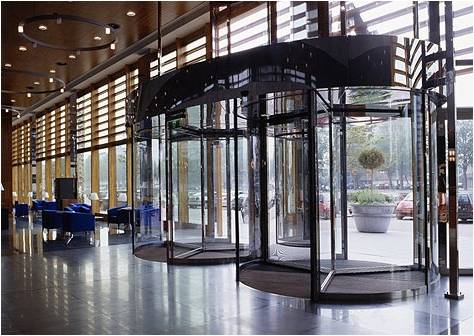Classification of applications of conductive slip rings in two-wing rotating automatic doors
Most through-hole slip rings use friction contact as the electrical connection form. It is safe, reliable, and can meet the number of channels required by customers. The slip rings currently on the market generally use this contact form. Others include mercury contact, infrared transmission, wireless transmission, etc., which are not mainstream products at present, because the disc slip rings produced in this way still have many limitations, such as the problem of mercury contact leakage, and it is difficult to manufacture more than 8 channels, and the production cost is very high. Infrared transmission and wireless transmission methods have signal interference problems, and high-current power channels cannot be transmitted in this way.
Slip ring assemblies can be divided into low-frequency slip rings, medium-frequency slip rings, and high-frequency rotating hinges according to the frequency of the transmission signal. Slip rings usually refer to only the first two types. The electrical performance indicators of slip ring assemblies are: insulation resistance, contact resistance, dielectric strength and crosstalk. For medium-frequency slip rings, because the frequency is high, shielding, impedance matching, noise voltage, etc. must also be considered. In terms of structural design, reliable contact must be ensured first to ensure that all lines are continuously connected. Therefore, the electrical conductivity of the material used for the brush is required to be good, the pressure on the slip ring should be appropriate, the eccentricity and shaking of the slip ring should be small, the wear resistance should be good, the friction torque should be small, and it should be easy to maintain.

- Low-frequency slip ring: a slip ring assembly that uses sliding contact to transmit low-frequency signals and energy. Common slip rings are cylindrical slip rings and differential slip rings. The conductive rings of cylindrical slip rings are divided into flat rings and V-shaped rings. The materials of the conductive rings are usually copper, brass, coin silver and gold. The brushes are palladium, gold alloy or gold-plated wire brushes and copper-graphite composite brushes. If the number of slip rings is large, the cylindrical slip ring consists of two sets of upper and lower brushes and a differential adapter, but its axial size is large. The use of differential slip rings can significantly reduce the axial size, volume and weight. The differential slip ring consists of two sets of upper and lower brushes and a differential adapter. The upper brush rotates with the azimuth of the antenna, while the lower brush is fixed. There are two sets of upper and lower contact pieces on the differential adapter plate. The corresponding contact pieces are connected by wires, and the differential mechanism is used to make its rotation speed 1/2 of the azimuth rotation speed. When the antenna rotates, the current flowing into each lower brush passes through one or two contact piece circuits on the differential turntable and flows out from the corresponding upper brush to ensure that the circuit between the fixed part and the rotating part is always connected. The powder worn by the sliding contact slip ring may cause a short circuit between the rings. Therefore, the structure should ensure that it is easy to clean, and a combined structure is usually used to facilitate on-site repair or replacement of components.
- Intermediate frequency slip ring: a slip ring assembly used to transmit radar intermediate frequency (tens of megahertz) signals and energy. This slip ring has a higher frequency and needs to be shielded. Ordinary high-speed slip rings can also be used to transmit signals below 12MHz. One ring is connected to the center conductor, and the other ring is connected to the outer layer of the cable as a shielding ring. Coaxial shielded slip rings are usually used to transmit signals above 12MHz. The cross-section of this slip ring is groove-shaped, which is essentially a rectangular coaxial conductor. There is also a capacitive intermediate frequency slip ring, the central conductor is annular, supported by an insulating pad in the shielding layer, there is a gap between the rotating part and the fixed part, and they do not touch each other, and the intermediate frequency signal is coupled through capacitance. In the case of limited antenna rotation range, a cable winding device can be used instead of a slip ring.

